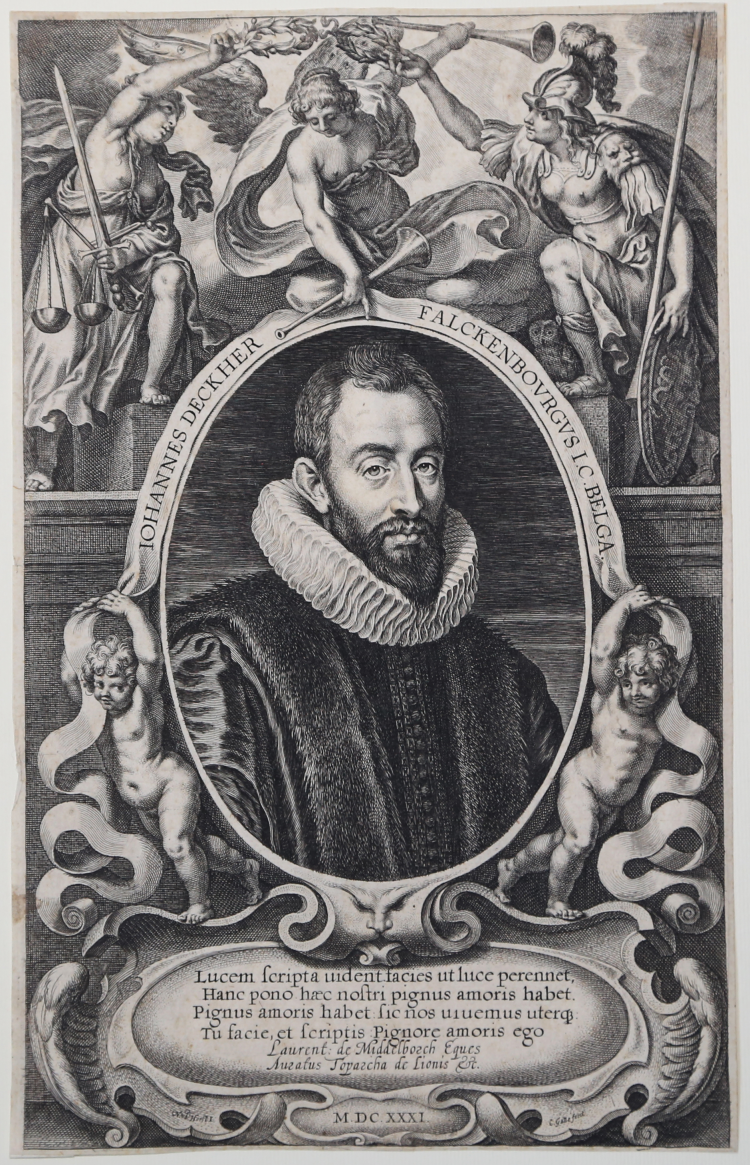




| Reference: | S40261.1 |
| Author | Cornelis GALLE |
| Year: | 1631 |
| Measures: | 180 x 291 mm |



| Reference: | S40261.1 |
| Author | Cornelis GALLE |
| Year: | 1631 |
| Measures: | 180 x 291 mm |
Engraving, 1631, signed on the left bottom: “N. vd Horst I.” and right: “C. Galle fecit”. After, Nicolaas van der Horst.
Only state.
On the bottom a cartouche with a Latin inscription: “Lucem scripta uident facies ut luce perennet, / Hanc pono haec nostri pignus amoris habet. / Pignus amoris habet sic nos vivemus uterq[...] / Tu facie, et scriptis: Pignore amoris ego / Laurent: de Middelbosch Eques / Ausatus Sopascha de Lionis &c'/ M.DC.XXXI”.
Good example, printed on contemporary paid paper, trimmed close to platemark, occasional light foxing scattered, a small satin on upper right corner, otherwise in good condition.
Portrait of Johannes Decker van Valckenburgh (1583 – 1646) in an oval surrounded with allegorical figures; two putti hold a ribbon with the name of the portrayed: “JOHANNES DECKER FALCKENBOURGUS I.C. BELGA”; above the oval personification of Justice and the armed Minerva are crowning the personification of Fama with laurels, at the centre, who is pointing in the direction of the portrayed.
|
Hollstein 282, Le Blanc 43
|
Cornelis GALLE (Anversa, 1576; Anversa, 29 Marzo 1650)
|
Engraver and publisher, son of Philip Galle. He was also a pupil of his father. In 1596 he visited Rome with his brother Theodor and remained there perhaps until 1610, when he became in Antwerp a member of the city’s Guild of St Luke. Shortly thereafter he founded a school of engraving in the city where many notable artists trained. The oeuvre of Cornelis Galle includes engravings after his own drawings as well as after compositions by other artists. During his stay in Rome, he made drawn copies of works by such artists as Raphael, Titian, Annibale Carracci, Giudo Reni and Jacopo Bassano, which he later used as preparatory designs for reproductive engravings after these Italian masters. Cornelis’s work for Rubens includes Judith Beheading Holofernes, known as the ‘Great Judith’, the Raising of the Cross, the Passion and the illustrations for the Vita beati P. Ignatii Loyolae. Cornelis Galle often engraved after the work of Anthony van Dyck (e.g. the Crucifixion). He also engraved works by numerous other Netherlandish artists including Marten de Vos, Hendrick Goltzius and Jacques Francuart; his engravings after the latter include the series of illustrations for the Pompa funebris optimi potentissimique Principis Alberti Pii (1623) by Erycius Puteanus (1574–1646). Cornelis Galle employed a traditional, dry engraving technique and style, typical of his father’s workshop. In the long term he could not produce work that satisfied Rubens’s requirements for reproductions of his paintings, and after 1610 the latter employed almost exclusively members of the Haarlem school for such work. However, Cornelis Galle retained Rubens’s patronage as an engraver of title-pages and book illustrations for Christoph Plantin.
|
|
Hollstein 282, Le Blanc 43
|
Cornelis GALLE (Anversa, 1576; Anversa, 29 Marzo 1650)
|
Engraver and publisher, son of Philip Galle. He was also a pupil of his father. In 1596 he visited Rome with his brother Theodor and remained there perhaps until 1610, when he became in Antwerp a member of the city’s Guild of St Luke. Shortly thereafter he founded a school of engraving in the city where many notable artists trained. The oeuvre of Cornelis Galle includes engravings after his own drawings as well as after compositions by other artists. During his stay in Rome, he made drawn copies of works by such artists as Raphael, Titian, Annibale Carracci, Giudo Reni and Jacopo Bassano, which he later used as preparatory designs for reproductive engravings after these Italian masters. Cornelis’s work for Rubens includes Judith Beheading Holofernes, known as the ‘Great Judith’, the Raising of the Cross, the Passion and the illustrations for the Vita beati P. Ignatii Loyolae. Cornelis Galle often engraved after the work of Anthony van Dyck (e.g. the Crucifixion). He also engraved works by numerous other Netherlandish artists including Marten de Vos, Hendrick Goltzius and Jacques Francuart; his engravings after the latter include the series of illustrations for the Pompa funebris optimi potentissimique Principis Alberti Pii (1623) by Erycius Puteanus (1574–1646). Cornelis Galle employed a traditional, dry engraving technique and style, typical of his father’s workshop. In the long term he could not produce work that satisfied Rubens’s requirements for reproductions of his paintings, and after 1610 the latter employed almost exclusively members of the Haarlem school for such work. However, Cornelis Galle retained Rubens’s patronage as an engraver of title-pages and book illustrations for Christoph Plantin.
|